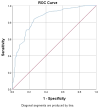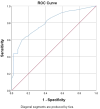Risk Factors and Predictive Model for Stress Hyperglycemia After Cardiac Surgery in Non-Diabetic Patients
- PMID: 40292223
- PMCID: PMC12032966
- DOI: 10.2147/JMDH.S515269
Risk Factors and Predictive Model for Stress Hyperglycemia After Cardiac Surgery in Non-Diabetic Patients
Abstract
Objective: To create and verify a model that predicts the risk of stress hyperglycemia (SHG) in patients without diabetes after cardiac surgery.
Design: Retrospective analysis.
Methods: This retrospective analysis analyzed patients without diabetes post cardiac surgery at our hospital between June 2020 and December 2023. The 333 patients from June 2020 to June 2022 constituted the developmental sample and the 162 patients from July 2022 to December 2023 constituted the testing sample.
Results: Of 495 patients, 356 (71.9%) developed SHG. Multivariable analysis identified hyperlipidemia, coronary artery bypass grafting (CABG), hypertension, blood transfusion, body mass index (BMI) ≥28 kg/m², and hyperoxia during cardiopulmonary bypass (PaO2≥300mmHg) as significant factors influencing SHG in patients without diabetes after cardiac surgery. The goodness-of-fit test for the risk prediction model based on these factors showed X² = 0.85, P = 0.588. The area under the receiver operating characteristic curve (AUC) for the modeling group was 0.85, with a maximum Youden index of 0.579, an optimal cutoff value of 0.637, a sensitivity of 83.4%, and a specificity of 74.5%. For the external validation group, the AUC was 0.805, with a Youden index of 0.704, 82.6% sensitivity, and 87.8% specificity, and a diagnostic value of 0.839.
Conclusion: Hyperlipidemia, CABG, hypertension, blood transfusion, BMI ≥28 kg/m², and hyperoxia during CPB (PaCO2≥300mmHg) are significant risk factors for SHG in patients without diabetes following cardiac surgery. The model constructed based on these factors can effectively predict the risk of SHG, providing a basis for early intervention measures reduce the incidence of this condition.
Keywords: R software; SHG; cardiac surgery; contributing factors; nursing; risk prediction model; stress hyperglycemia.
© 2025 Zhang et al.
Conflict of interest statement
The authors have no conflicts of interest related to this scientific work.
Figures
Similar articles
-
A novel nomogram to predict perioperative acute kidney injury following isolated coronary artery bypass grafting surgery with impaired left ventricular ejection fraction.BMC Cardiovasc Disord. 2020 Dec 10;20(1):517. doi: 10.1186/s12872-020-01799-1. BMC Cardiovasc Disord. 2020. PMID: 33302875 Free PMC article.
-
[Myocardial scar area predicts major adverse cardiovascular events after coronary artery bypass grafting in patients with ischemic cardiomyopathy].Zhonghua Xin Xue Guan Bing Za Zhi. 2024 Aug 24;52(8):906-913. doi: 10.3760/cma.j.cn112148-20231107-00415. Zhonghua Xin Xue Guan Bing Za Zhi. 2024. PMID: 39143782 Chinese.
-
Machine-learning predictions for acute kidney injuries after coronary artery bypass grafting: a real-life muticenter retrospective cohort study.BMC Med Inform Decis Mak. 2023 Nov 23;23(1):270. doi: 10.1186/s12911-023-02376-0. BMC Med Inform Decis Mak. 2023. PMID: 37996844 Free PMC article.
-
Neutrophil gelatinase associated lipocalin as a biomarker for acute kidney injury in patients undergoing coronary artery bypass grafting with cardiopulmonary bypass.Ann Vasc Surg. 2010 May;24(4):525-31. doi: 10.1016/j.avsg.2010.01.001. Epub 2010 Apr 2. Ann Vasc Surg. 2010. PMID: 20363104 Review.
-
Systemic immune-inflammation index for predicting postoperative atrial fibrillation following cardiac surgery: a meta-analysis.Front Cardiovasc Med. 2024 Feb 5;11:1290610. doi: 10.3389/fcvm.2024.1290610. eCollection 2024. Front Cardiovasc Med. 2024. PMID: 38374999 Free PMC article. Review.
References
-
- Xiaojue L, Xiaopei H, Heng Z, et al. Association between stress hyperglycaemia and in-hospital cardiac events after coronary artery bypass grafting in patients without diabetes: a retrospective observational study of 5450 patients. Diabetes Obesity Metab. 2023;25:S1. - PubMed
-
- Li XT, Wei J, Mo HP, et al. Early blood glucose changes and nursing care in patients without diabetes after coronary artery bypass grafting. Evidence-Based Nursing. 2017;3(04):298–302.
LinkOut - more resources
Full Text Sources





